This is just too cool.
So, most of you know how I collect and archive every possible image of historical harp guitars. My goal is simply a decent digital scan; I certainly don’t need, want, nor can afford all the originals. Still, it’s quite delightful to hold in your hand the actual article displaying some of these iconic images – be it a rare postcard, photograph, or cabinet card of varying sizes.
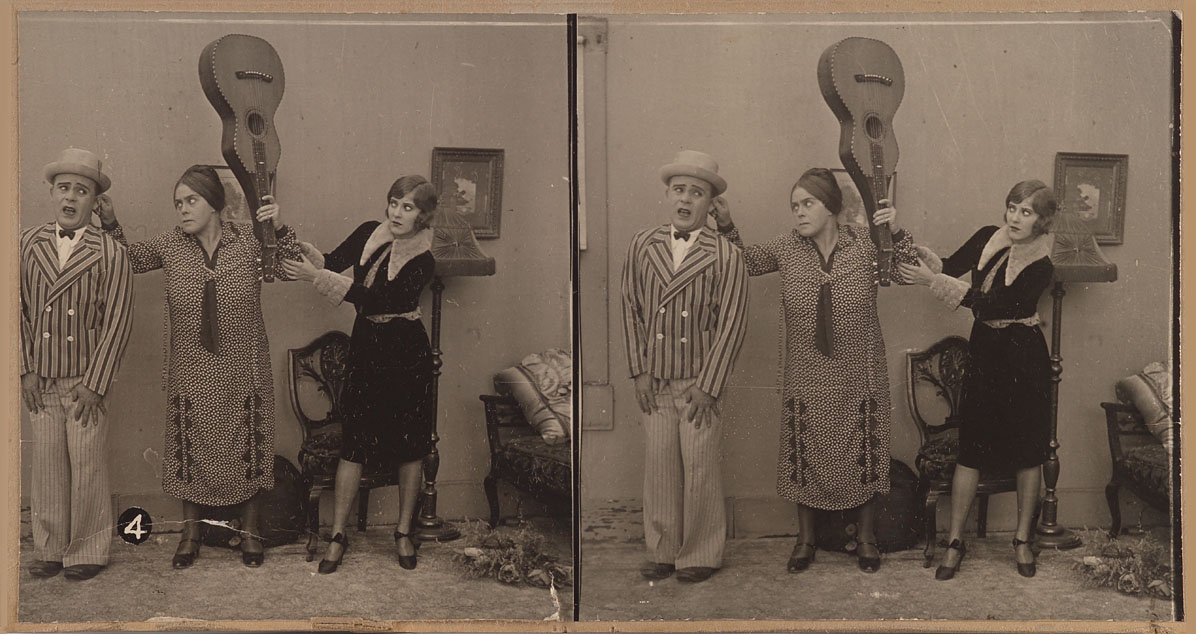
Perhaps rarest and coolest yet was my friend Ben Elder’s stereo card with a genuine Knutsen steel guitar in it (above). Yes, I also have a small collection of musician stereo cards and a nice antique stereoscope with which to enjoy them – but so far, no harp guitars.
![]() Then in mid-May I discovered an entire new world of charming antique collectibles, when I found on eBay an incredible harp guitar image in the form of a magic lantern glass slide. Surprisingly, the term was new to me (and this from a guy who’s been haunting antique shops and flea markets religiously for decades). I quickly discovered that these slides – evolved throughout different technologies over a century and a half – were made as projected images for the home or theater, often part of elaborate phantasmagorias of sight and sound. This served as entertainment until movies and radio finally made them obsolete (though something similar would be resurrected in the obligatory – and now sorely missed – slide shows our parents made of every summer trip!).
Then in mid-May I discovered an entire new world of charming antique collectibles, when I found on eBay an incredible harp guitar image in the form of a magic lantern glass slide. Surprisingly, the term was new to me (and this from a guy who’s been haunting antique shops and flea markets religiously for decades). I quickly discovered that these slides – evolved throughout different technologies over a century and a half – were made as projected images for the home or theater, often part of elaborate phantasmagorias of sight and sound. This served as entertainment until movies and radio finally made them obsolete (though something similar would be resurrected in the obligatory – and now sorely missed – slide shows our parents made of every summer trip!).
I couldn’t quite decipher the instrument in the listing photo, and as I thought this interesting medium was just too unusual to pass up, I put in a serious hefty bid – thrilled to then get it and a companion piece for the opening offer of just $19.99 each. Hey, you lose some, you win some.
![]()
It gets better.
The two slides were said to be from the 1920 period (the final decade it seems for this “magic slide” medium) – true or not, I don’t yet know. Both have a paper label of C. M. Brashear (the studio is listed in the 1920 directory of Little Rock, Arkansas; I’ve no idea how much earlier he was in business), and include at least two of the same band members and same 6-string guitar in the two shots of the extravagantly theatrical string groups. The images are enchantingly hand-tinted, the colorist giving the solid pearl fretboard a crude bit of green sheen among other touches. I believe this is done directly on a large positive film transparency, before it’s sandwiched between two thin plates of glass and taped together with black cloth tape. I spent a good hour or two with my media guy (and two different high-end cameras and lenses) to shoot these sharp, optimized backlit digital images.
![]()
Even if these particular slides were produced around 1920, the photographs seem earlier to me – and if not, of course the instruments could have been built many years before. And that’s exactly what I think (very cool reveal to come). But first, what of that harp guitar?
![]()
![]()
From the listing, I had determined that the main neck must be a 12-string – and that turned out to be the case. The strange “bass” neck though, turned out not to have subs. It’s actually a second 12-string neck, but shorter (terz tuning a third higher?) and unfretted (!?!).
Wait – so it’s not a harp guitar?
Yes! Because strung between the two 12-string necks on the body is a bank of open harp strings!
This is a first. We’ve seen a few harp guitar “Form 4” inventions with harp/zither strings placed on the body on either side of the neck…but never the reverse. How strange and wonderfully impractical! It looks like there are six extra strings, in some non-linear “re-entrant” tuning of thin and thick – but the first (last?) string is weird, as if it has a super thick winding partway up. Ideas? Where the tuners are located for these strings I can’t quite make out. They could be at either end of the body, though I expect they’re mounted to the tail, whatever they are.
![]()
![]()
![]()
All in all, an outrageous, one-of-a-kind instrument. Overly fancy, too, like its 6-string guitar “twin” at left. Both have butterfly-ensconced inlaid pickguards below the soundhole and below the bridge, with additional fancy inlays on the soundboards of the elaborately-bound bodies. The 6-string looks like it has a solid pearl fingerboard with fancy inlaid or engraved fret markers, while the double-neck HG has two full vine inlays. This group wanted to make an impression! Even their mandolin is unique – a fancy ten-string bowlback, perhaps by the same maker.
And who might this maker be?
To me, that distinctive guitar body with the “wide hips” just screams “Tony Biehl.” Huh? Who the heck is Tony Biehl?
In the 1890’s, he was quite a well-known mandolin & guitar teacher, performer and composer who also sold quality guitars and mandolins in Davenport, Iowa. In fact, his ad appeared in the very first issue of The Cadenza in 1894 – the first harp guitar builder/brand to do so – and ran consistently for years. Biehl had a small “factory,” employing cabinet makers to build his mandolins and guitars and may have had a hand in building some of the instruments himself. Despite their excellent quality, and Biehl’s location – the major Midwest-supplying hub of the rapidly growing city of Davenport on the Mississippi River – he was bankrupt by 1904, quitting the manufacturing business to travel and perform with his daughters.
By great good fortune, I happen to have an original Biehl harp guitar and am thus intimately attuned to its unique silhouette. By sheer luck, both guitars in the slides appear in front view, so I overlaid transparent images of all three instruments on top of each other, and was amazed how perfectly the bodies (and neck and soundhole) lined up.
![]()
Still unsure whether other turn-of-the-century builders might have done something similar (anyone know of other guitars this shape?), I happened to notice the distinctive slots of my Biehl headstock: straight, rectangular-cut from the top to the bottom, where they flare out into wide spoon shapes. Lo and behold, the magic slide 6-string sure looks identical! Note also the staggered bridge pins on mine and the magic slide HG above. Here is another plain Biehl 6-string with the same body and tuner slots (thanks to Rodger Wilming).
![]()
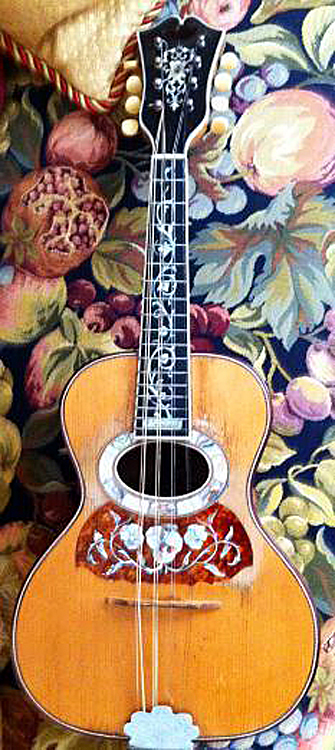 M
M
y instrument is of course quite plain (though of very fine quality and fantastic tone), as are a couple other Biehl guitars seen. But the small Biehl factory also produced “presentation grade” mandolins, such as this mandolinetto, and a similarly fancy bowlback. The magic slide guitars would fit right in with this aesthetic to my eye.
If we establish that these instruments are indeed Biehl’s – and I’m largely convinced – and know that Biehl was in production by 1894 and only produced instruments until 1904, then we have yet another possible bonanza: that Biehl is now a potential contender for introducing the first 12-string neck guitar in America. Re-familiarize yourself with my Birth of the American 12-string Guitar article – and also note the last section where I point out how 12-string necks (or doubled strings in general) often went hand in hand with harp guitars.
Of course you know I wasn’t about to just stick these in a dark drawer…not when I could hunt for an authentic period Balopticon to project them in all their original glory!
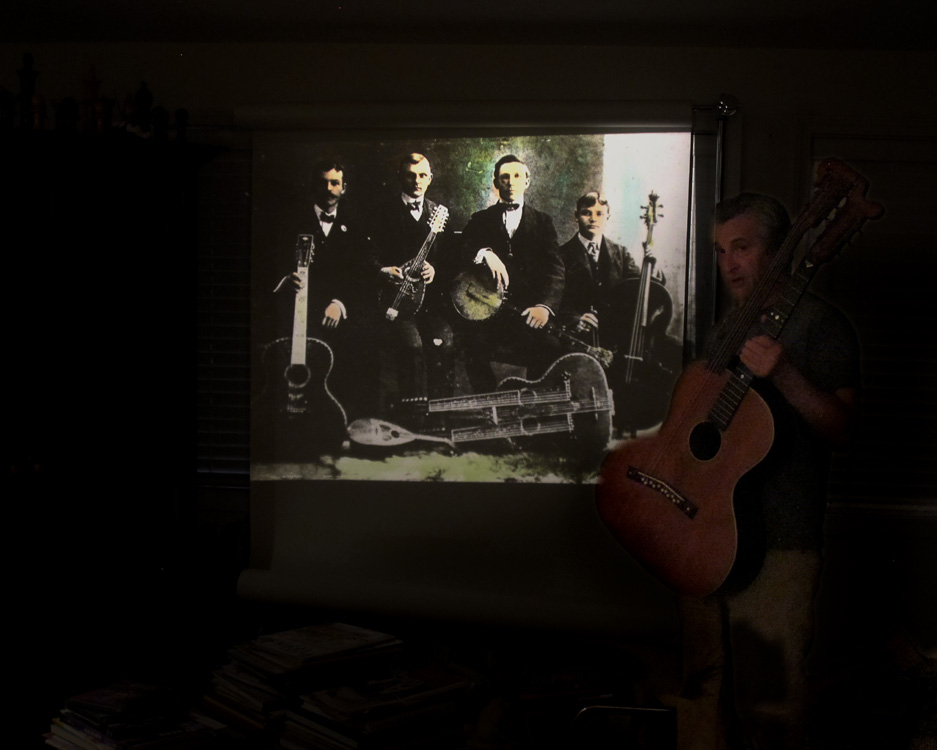
Now I gotta find more cool images, so every Sunday night can be family magic lantern night.


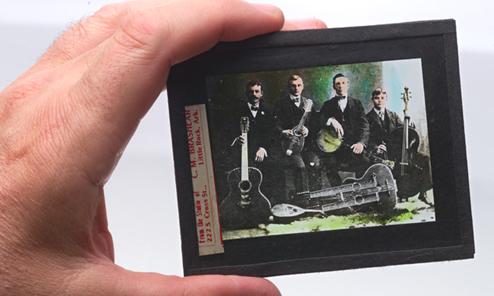
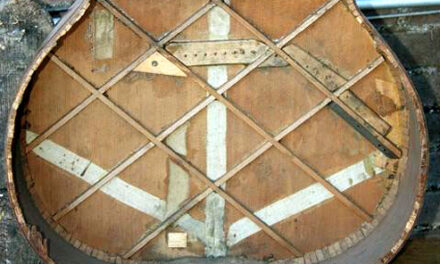
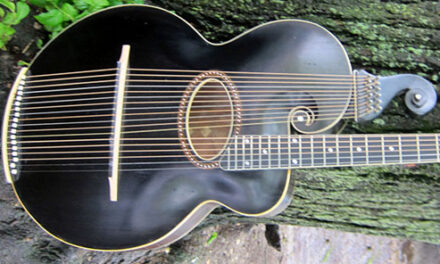
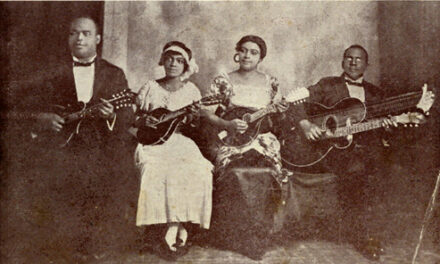
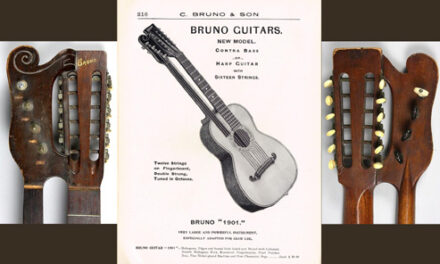
I have been restoring a Biehl harp guitar that came to me in horrible condition. It doesn’t have the extremely wide out-of-proportion lower bout. It has two necks, about the same body shape and size (16″ lower bout) as a Martin 0000 guitar, but with dreadnaught depth, and is ladder braced. Thanks for the postings!
John – we need to add your instrument to the site! Please send pics when able.
My boyfriend repairs stringed instruments & collects vintage ones. Just brought home what turns out to be a Biehl guitar. We’ve never heard of Tony Biehl, but you all sure have. It’s about 19″ wide at the bottom, seen better years, but we wuld certainly like to know more or where to find more information. Read about him producing instruments for about 10 years in the late 1800’s/early 1900’s. I would download photos if I could…it’s mahogany back & sides.
Totally cool! The pegheads are kind of stock shape, but those scooped ramps on the slots are very unusual. The body shape is so distinctive it’s hard to believe it could not be the same builder. I really couldn’t see frets on the short neck, but then I zoomed in on the image of it horizontal in front of the band, and, yep, it does look like there are frets there.
What a thing!
Gregg. how common was that crescent moon inlay on the headstock.
I know I’ve seen it once on the Gibson C acoustic 1900.
But also on a Knutsen harp guitar, page 68 in Tom’s book
and in the patent on p12 (as soundholes).
Is there a link?
Really looking forward to seeing those photos.
I can’t see the treble strings either on the Terz neck but can see them over the body.
That’s what makes me feel the frets are there.
Tony Biehl a lost national treasure?
My wife’s family name is Biehl, and Tony was her great-uncle. We have two Biehl guitars including one of the wide bodies. I mentioned Biehl guitars at page 150 in my book, but nobody ever picked up on it.
Tom, you’ve got to be kidding! Nancy is a Biehl great niece?! You guys are true harp guitar royalty. Any family lore?
Please forward some pics of your guitars when you can (I’ll do an HG of the Month on my Biehl someday). There’s a lovely shot of Biehl and his 3 daughters in the upcoming mandolin book by Graham McDonald as well.
Ah yes, I see you mentioned the Biehl triangular inlay in your book (oh, for that index…!).
Another brilliant find!
Perhaps my imagination, but I think the Terz fingerboard was fretted. Makes sense.
I don’t usually go for fancy guitars, but these are quite exceptional.
But so much more refined and elaborate than your Biehl, yet obviously one of his.
Those spooned out peg head slots are the give away.
Great job, thanks.
Sean – actually, even the unadorned Biehl’s are still quite refined. Yeah, I imagined frets too (or is that just bits of the fancy inlay?). How small would they have to be to disappear completely from the edge of the fb, while the longer neck clearly shows every location?
You are right–this is just so cool! I have never heard of Tony Biehl. More new things to learn about, if only there were enough time for all one wants to do. But I had heard of magic lantern glass slides before, though I did not know just how special they are, and I had certainly never seen one until this picture above. Love the rapt expressions on all the faces, too!